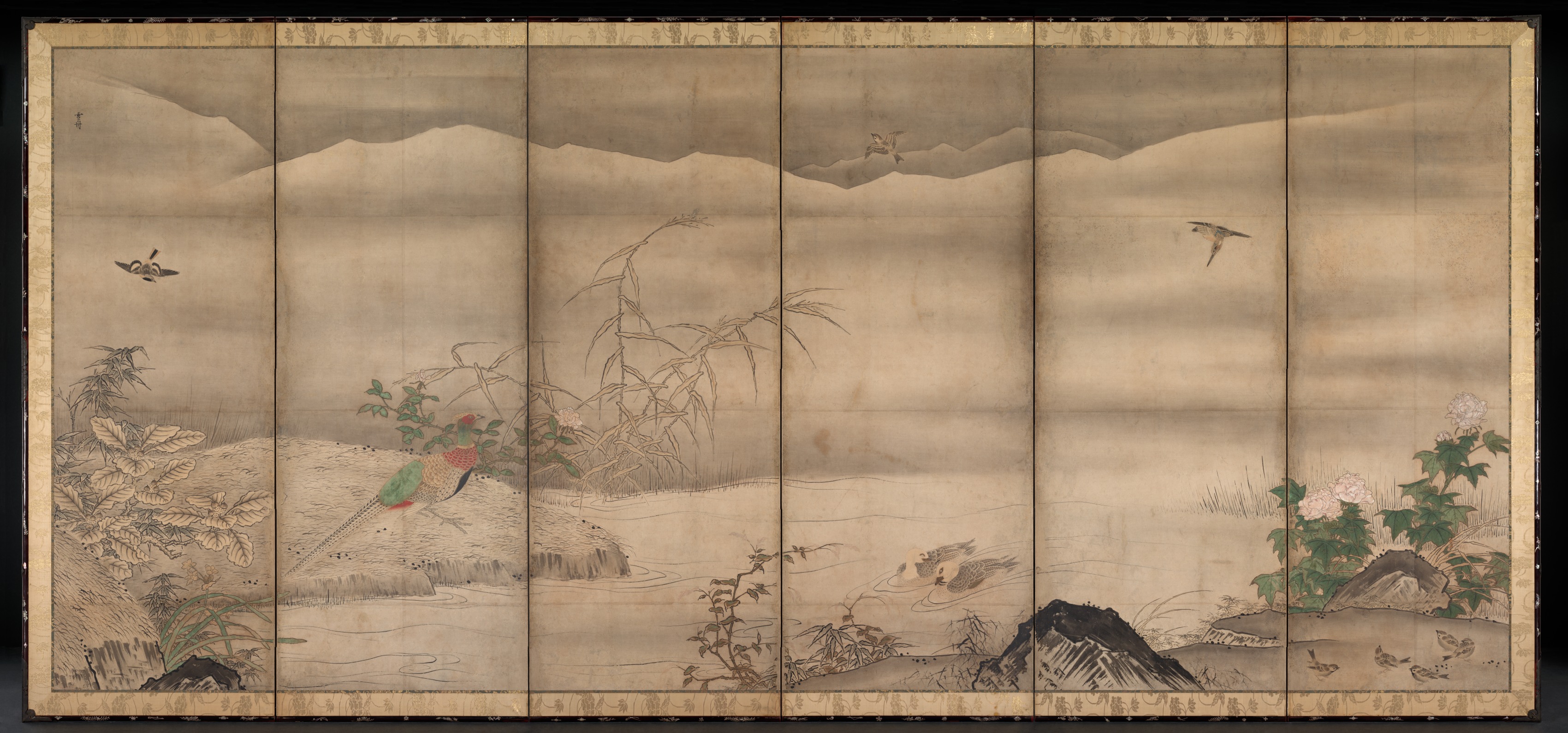The Cleveland Museum of Art
Collection Online as of April 21, 2024

Birds and Flowers in a Landscape of the Four Seasons
1550–99
follower of Sesshū Tōyō
(Japanese, 1420–1506)
Image: 158.5 x 359.4 cm (62 3/8 x 141 1/2 in.); Panel: 62.8 cm (24 3/4 in.); Including mounting: 174.6 x 281 cm (68 3/4 x 110 5/8 in.)
Purchase from the J. H. Wade Fund 1961.204
Location: not on view
Description
The monk-painter Sesshp is revered today, as he was in his own time. While he left Kyoto's sophisticated intel-lectual and cultural environment to live in a provincial village in a far western province, he seems never to have severed contacts with the monastic communities of his young adulthood. His residence in Yamaguchi proved fortuitous because his patron, the region's military lord, enjoyed considerable freedom in conducting trade missions overseas with Korea and China. Sesshp went to China in 1467 and traveled about the country, visiting well-known historical sites and Chan (Zen) temples before returning two years later. Thus he became familiar with contemporary painting practices, materials, formats, and subject matter. His assimilation and then transmission of these elements had a profound impact on the following generations of ink painters, patrons, and Zen communities throughout Japan. Despite the presence on these byøbu of the name "Sesshp," they are from the hand of another accom-plished but as yet anonymous follower active in the middle of the sixteenth century. Sesshp's name here, as on a handful of similar bird-and-flower byøbu, attests to the master's identification at that time with the colorful mural paintings on the same theme emanating from Ming dynasty China. This genre had heretofore been relegated to hanging scroll compositions, so the intro-duction into temple and daimyo residences of such an attractive theme surely caused considerable excitement in the later fifteenth century, when in all likelihood Sesshp introduced it into the Japanese painting reper-toire. Subsequently, artists of varying backgrounds and training tried their hands at these large, dramatic scenes. From right to left the composition portrays an array of flowering plants in the near distance that indicate the passage of the seasons. Birds, usually paired, occupy this setting, engaged in various activities that lend naturalism and an air of peacefulness. The world they inhabit may be characterized pictorially by expansive middle-ground waterscapes that end where the far distant mountains rise as backdrops. These features appear consistently in other bird-and-flower byøbu attributed to Sesshp. Also noteworthy is the absence of any birds of prey such as the samurai's beloved hawks, emblems of fierceness and graceful strength that appear often in the byøbu of sixteenth-century Kano and Soga school painters.- D. Konoike, Osaka, Japan?–1961(Howard Hollis and Co., Cleveland, OH, sold to the Cleveland Museum of Art)1961–The Cleveland Museum of Art, Cleveland, OH
- The Cleveland Museum of Art. Handbook of the Cleveland Museum of Art/1966. Cleveland, OH: The Cleveland Museum of Art, 1966. Reproduced: p. 278 archive.orgThe Cleveland Museum of Art. Handbook of the Cleveland Museum of Art/1969. Cleveland, OH: The Cleveland Museum of Art, 1969. Reproduced: p. 278 archive.orgCleveland Museum of Art, and Michael R. Cunningham. Unfolding Beauty: Japanese Screens from the Cleveland Museum of Art. Cleveland, OH: Cleveland Museum of Art, 2001. Reproduced: p. 12-13
- Main Asian Rotation (Gallery 236). The Cleveland Museum of Art, Cleveland, OH (December 24, 2013-July 21, 2014).Main Asian Rotation (G121). The Cleveland Museum of Art, Cleveland, OH (October 26, 2003-March 12, 2004).Byobu: The Art of the Japanese Screen. The Cleveland Museum of Art, Cleveland, OH (organizer) (December 8, 1987-January 10, 1988).Year in Review (1961). The Cleveland Museum of Art, Cleveland, OH (organizer) (November 1-26, 1961).
- {{cite web|title=Birds and Flowers in a Landscape of the Four Seasons|url=false|author=Sesshū Tōyō|year=1550–99|access-date=21 April 2024|publisher=Cleveland Museum of Art}}
Source URL:
https://www.clevelandart.org/art/1961.204